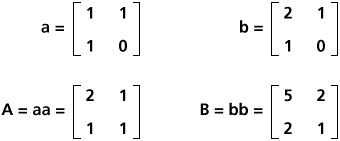calculating Markoff numbers with matrices
Markoff numbers
can be calculated with the aid of particular kinds of continued fractions
(see Frobenius for details).
However, analogous calculations can be achieved with matrix multiplication,
which provides a simpler illustration of the process.
So, although I like continued fractions, I will use matrices here.
First, define two matrices, a and b, as follows.
Below them are matrices A and B, formed by
squaring a and b (respectively).

Any Markoff number (except for 1 or 2) can be calculated
by taking a particular product of these matrices and examining the
upper-left element of the resulting product matrix. For example:
7561 is the upper-left element in the matrix
generated as the product bABAABAb. (This kind of notation for
the product of a string of matrices is unambiguous, as matrix
multiplication is associative.) The bABAABAb matrix is as follows:

Next to each Markoff number in the tree below is the form of the matrix
product (in blue) which generates it:

Each matrix product expression (bb, bABAb, etc.) is
palindromic. Each expression begins and ends with
matrix b; all other terms are A and B matrices. The initial
and final b matrices are shown in light blue above; the patterns
of A and B terms (in dark blue) are the interesting part. The
patterns of A and B terms exhibit the following properties:
-
The tree has a complementary symmetry about its center line: the pattern
of A and B terms for any number in the tree is the complement
of the pattern for the number in the corresponding location in the other
half of the tree. E.g, 7561 (ABAABA) and 37666 (BABBAB).
- The Fibonacci numbers along the bottom edge of the tree have patterns comprised solely of A terms (A, AA, AAA, ...); each pattern has one more A term than its predecessor. The Pell numbers on the other side of the tree have complementary patterns comprised solely of B terms (B, BB, BBB, ...).
Two conjectures (which I've since been told are both provable):
-
Frobenius describes a method for
generating the pattern of A and B terms in these matrix products.
I have found a different method; I don't know whether it always gives
the same results as the method described by Frobenius, but I have
verified that it does for over 200,000 Markoff numbers.
In this method, the pattern for any other (non-edge) number in the tree is derived from the two (spatially) closest numbers in the preceding level. E.g., for 51461, the two closest numbers in the preceding level of the tree are 1325 and 7561. The new pattern is the shortest possible pattern which starts and ends with the closer of the two preceding patterns, and has the other preceding pattern at its center. E.g., the pattern for 51641 is AABAABAA, which is the shortest possible pattern that starts and ends with AABAA (from 1325, its closer predecessor) and has ABAABA at its center (from 7561, its other predecessor).
Note: Dr. Serge Perrine informs me that a proof of this conjecture can be found in his book La théorie de Markoff et ses développements.
-
Any other permutation of the A and B terms in the matrix product
associated with a Markoff number yields a matrix whose upper-left
corner element is higher than the Markoff number. For example,
these are the upper-left corner elements associated with the 15 distinct
matrix products bXb, where X is comprised of five A and two B matrices:
bAAAABBb : 7825 bAAABABb : 7661 bAABAABb : 7639 bABAAABb : 7649 bBAAAABb : 7741 bAAABBAb : 7729 bAABABAb : 7571 bABAABAb : 7561 bBAAABAb : 7649 bAABBAAb : 7717 bABABAAb : 7571 bBAABAAb : 7639 bABBAAAb : 7729 bBABAAAb : 7661 bBBAAAAb : 7825
Note that smallest value in the list, 7561, is the Markoff number associated with patternbABAABAb. I have verified this conjecture for over 200 Markoff numbers, including all 127 in the first seven levels of the tree. In every case, the Markoff number was lower than the upper-left corner element of the matrix product of any other permutation of the same number of A and B terms. These verifications can be time-consuming; the patterns quickly grow long, giving many permutations to evaluate. For example, there are 548354040 distinct bXb patterns where X is comprised of 22 A terms and 12 B terms; of those,bABAABAABAABABAABAABAABABAABAABAABAbyields the lowest upper-left corner element in its matrix product: the Markoff number 8976259355318572981.
Note: Dr. Serge Perrine informs me this conjecture is also easily proven.
Tom Ace
return to Tom's main Markoff number page
return to Tom's home page